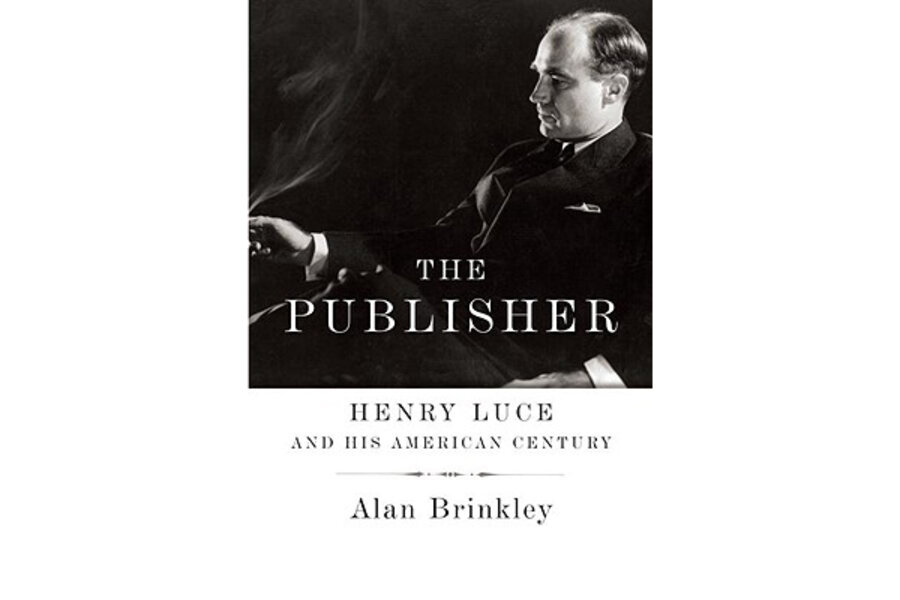The Publisher
Loading...
So many books focused on the years 1900-2000 use the words “American Century” in the title or subtitle that I have become suspicious of them. It is an ethnocentric and sometimes downright xenophobic phrase, suggesting the United States of America is, appropriately or not, the center of the universe.
But a biography of magazine publisher Henry Luce (1898-1967) can legitimately employ the clichéd phrase. Why? Because Luce either coined it or, at minimum, made it a familiar part of the English language through the magazines he published – especially Time, Fortune, Life, and Sports Illustrated.
As a biographer myself, I am also suspicious of biographies that recount the lives of famous folks already chronicled multiple times. Why, I wondered, would Columbia University history professor Alan Brinkley spend years on a Luce biography when W.A. Swanberg and other skilled professionals had already told the Luce saga?
Brinkley answers that question in his preface to The Publisher: Henry Luce and His American Century, as he discloses that Swanberg’s interpretation of Luce, published during 1972, seemed crabbed and therefore ultimately open to debate.
To Swanberg and other chroniclers of Luce’s life, what seemed important, according to Brinkley, “was his arrogance, his dogmatism and his reactionary, highly opinionated politics – all of which found reflection in his magazines.” The stereotype of Luce held that he had become a cold warrior who hated the Soviet version of Communism and campaigned against the Communist takeover of China. Luce blindly supported capitalism and the Republican Party, despite their flaws, the stereotype continued.
All true to some extent, Brinkley posits, “but Luce was other things as well.” As a publisher, he and partner Briton Hadden pretty much invented the weekly news magazine, giving birth to Time in 1923 shortly after both men had graduated from Yale University. Then Luce invented the modern business magazine with the debut of Fortune, the modern photojournalism magazine with the debut of Life, and the modern sports magazine with the debut of Sports Illustrated.
Furthermore, Luce demonstrated an open mind on numerous crucial issues other than China, the Soviet Union, Communism, capitalism, and Republican Party politics. In fact, Luce used his increasingly influential magazines to promote civil rights, especially for African-Americans.
The biography is pretty much relentlessly chronological, but that standard structure does not suggest that it is boring. Brinkley is a first-rate stylist, which helps sustain interest. Even better, he is a first-rate researcher, digging into the Luce and Time Incorporated archives to unearth fascinating details about Luce’s unusual childhood, unusual family situation, competitive years at Yale, and remarkable success within the magazine world by age 25. Furthermore, Brinkley demonstrates that the apparent curmudgeon had a lively love life involving multiple extraordinary women, including his second wife, Clare Boothe Luce, who achieved celebrity status as a writer, actress, elected politician, and diplomat.
Brinkley’s account of Henry Luce’s life before college is especially attention-getting, because biographers often locate only scant material illuminating the childhood, adolescence, and young adulthood of their subjects. Luce, however, left behind insightful material starting at about age 10. He was brainy, self-reliant, self-conscious, and able to convey complex thoughts with apparent ease.
Luce spent much of his childhood in China, a vast, mysterious nation barely open to Americans. Although never poverty-stricken, Luce’s father and mother lived with relative deprivation as their missionary zeal drove them to convert the Chinese masses to Christianity. Son Harry lived mostly inside the missionary compound, cut off from the Chinese masses. Still, he understood Chinese culture far more intimately than most Westerners, and later in life he became involved in Chinese politics with sometimes ugly results for the Sino-American diplomatic dance.
Well-to-do Americans who admired the missionary zeal of the Luce family in China helped pay for Henry’s entry into the upper-class, expensive Yale University enclave. Luce did not fit well with those to-the-manor-born. But his ambition to live like the truly wealthy led him to strive beyond reason for acceptance. He achieved excellent grades, became a literary force on campus, and managed to forge a few friendships, however tentative.
Although Luce was as staid as Hadden was wild, their fractious relationship on the Yale campus somehow bloomed into fiery friendship and then, after they graduated from Yale, an innovative business partnership. Hadden is every bit as much the father of the news magazine as Luce. But because Hadden lived recklessly and died young (1898-1929), he became the mostly forgotten partner.
Hadden’s death naturally saddened Luce, but did not paralyze him. As the sole publisher of the Time empire, Luce no longer had to answer to a charismatic partner who had often prevailed while alive.
Brinkley the biographer masterfully juggles the growth of Luce’s magazine empire; the first romance that led to what looked like a storybook marriage but was not (two sons resulted); the unlikely meeting with and courtship of Clare Boothe; the growing hatred Luce demonstrated for President Franklin Delano Roosevelt and the concomitant romance with Republicans, especially President Dwight Eisenhower; Luce’s increasing haughtiness and loneliness, leading to gossipy publicity both unwanted and strangely treasured; plus so much more.
Brinkley’s material is so rich and presented so well that readers without a preexisting interest in Luce quite likely will find themselves sucked in to the narrative.
Steve Weinberg is author of “Taking on the Trust: The Epic Battle of Ida Tarbell and John D. Rockefeller.”






